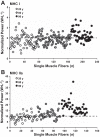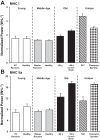Improved single muscle fiber quality in the oldest-old
- PMID: 27516537
- PMCID: PMC5142307
- DOI: 10.1152/japplphysiol.00479.2016
Improved single muscle fiber quality in the oldest-old
Abstract
We examined single muscle fiber contractile function of the oldest-old (3F/2M, 89 ± 1 yr old) enrolled in The Health, Aging, and Body Composition Study (The Health ABC Study). Vastus lateralis muscle biopsies were obtained and single muscle fiber function was determined (n = 105) prior to myosin heavy chain (MHC) isoform identification with sodium dodecyl sulfate-polyacrylamide gel electrophoresis. Cross-sectional area of MHC I muscle fibers (5,576 ± 333 μm2; n = 58) was 21% larger (P < 0.05) than MHC IIa fibers (4,518 ± 386 μm2; n = 47). Normalized power (an indicator of muscle fiber quality incorporating size, strength, and speed) of MHC I and IIa muscle fibers was 2.3 ± 0.1 and 17.4 ± 0.8 W/l, respectively. Compared with previous research from our lab using identical procedures, MHC I normalized power was 28% higher than healthy 20 yr olds and similar to younger octogenarians (∼80 yr old). Normalized power of MHC IIa fibers was 63% greater than 20 yr olds and 39% greater than younger octogenarians. These comparative data suggest that power output per unit size (i.e., muscle quality) of remaining muscle fibers improves with age, a phenomenon more pronounced in MHC IIa fibers. Age-related single muscle fiber quality improvements may be a compensatory mechanism to help offset decrements in whole muscle function.
Keywords: aging; contractile function; muscle quality; oldest-old; single fiber.
Figures



Comment in
-
Age-related changes in skeletal muscle function: the sum of the parts could be greater than the whole.J Appl Physiol (1985). 2016 Nov 1;121(5):1234. doi: 10.1152/japplphysiol.00770.2016. J Appl Physiol (1985). 2016. PMID: 27881625 No abstract available.
-
Reply to Venturelli and colleagues.J Appl Physiol (1985). 2016 Nov 1;121(5):1235. doi: 10.1152/japplphysiol.00832.2016. J Appl Physiol (1985). 2016. PMID: 27881626 Free PMC article. No abstract available.
References
-
- Andersen JL, Klitgaard H, Saltin B. Myosin heavy chain isoforms in single fibres from m. vastus lateralis of sprinters: influence of training. Acta Physiol Scand 151: 135–142, 1994. - PubMed
-
- Andersen JL, Mohr T, Biering-Sørensen F, Galbo H, Kjaer M. Myosin heavy chain isoform transformation in single fibres from m. vastus lateralis in spinal cord injured individuals: effects of long-term functional electrical stimulation (FES). Pflügers Arch 431: 513–518, 1996. - PubMed
-
- Aniansson A, Grimby G, Hedberg M. Compensatory muscle fiber hypertrophy in elderly men. J Appl Physiol 73: 812–816, 1992. - PubMed
-
- Bean J, Leveille S, Kiely D, Bandinelli S, Guralnik J, Ferrucci L. A comparison of leg power and leg strength within the InCHIANTI study: which influences mobility more? J Gerontol A Biol Sci Med Sci 58: 728–733, 2003. - PubMed
-
- Bergström J. Muscle electrolytes in man. Scand J Clin Lab Invest 68: 1–110, 1962.
Publication types
MeSH terms
Grants and funding
LinkOut - more resources
Full Text Sources
Other Literature Sources
Medical
Research Materials
Miscellaneous

